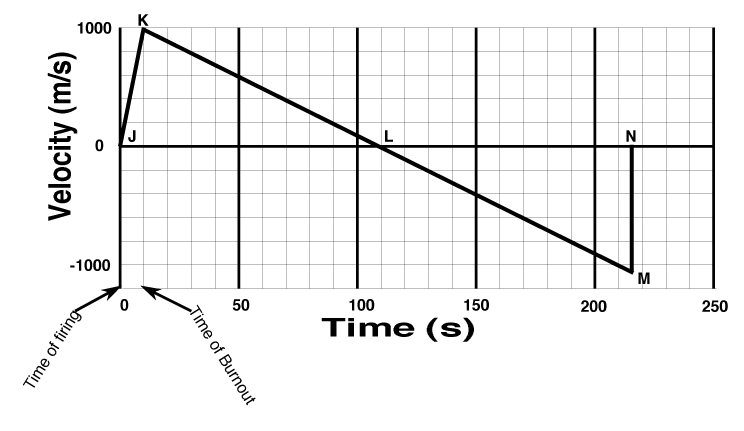A small rocket was fired vertically on an atmosphere-free planet (see graph). What was the approximate acceleration during the burning of the rocket? At what time does the rocket reach its maximum height? What is the velocity of the rocket just as it reaches its maximum height? What is the maximum altitude reached by the rocket? Which of the following statements, describing the graph are true? (If A and E are true, and the others are not, enter TFFFT). A) The velocity at the maximum height depends on the magnitude of the maximum height B) In section KL, the displacement of the rocket has the opposite sign of the displacement in section LM. C) In section KL, the acceleration is positive. D) The velocity is greatest at point K. E) The area of triangle JKL is exactly equal to the area of triangle NML, because the distance that the rocket rises is equal to the distance that it falls.
Displacement, Velocity and Acceleration
In classical mechanics, kinematics deals with the motion of a particle. It deals only with the position, velocity, acceleration, and displacement of a particle. It has no concern about the source of motion.
Linear Displacement
The term "displacement" refers to when something shifts away from its original "location," and "linear" refers to a straight line. As a result, “Linear Displacement” can be described as the movement of an object in a straight line along a single axis, for example, from side to side or up and down. Non-contact sensors such as LVDTs and other linear location sensors can calculate linear displacement. Non-contact sensors such as LVDTs and other linear location sensors can calculate linear displacement. Linear displacement is usually measured in millimeters or inches and may be positive or negative.
A small rocket was fired vertically on an atmosphere-free planet (see graph). What was the approximate acceleration during the burning of the rocket? At what time does the rocket reach its maximum height? What is the velocity of the rocket just as it reaches its maximum height? What is the maximum altitude reached by the rocket?
Which of the following statements, describing the graph are true? (If A and E are true, and the others are not, enter TFFFT).
A) The velocity at the maximum height depends on the magnitude of the maximum height
B) In section KL, the displacement of the rocket has the opposite sign of the displacement in section LM.
C) In section KL, the acceleration is positive.
D) The velocity is greatest at point K.
E) The area of triangle JKL is exactly equal to the area of triangle NML, because the distance that the rocket rises is equal to the distance that it falls.

Trending now
This is a popular solution!
Step by step
Solved in 3 steps









